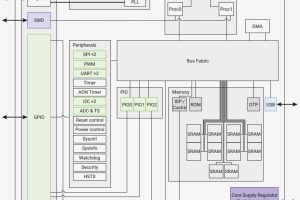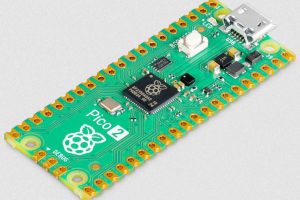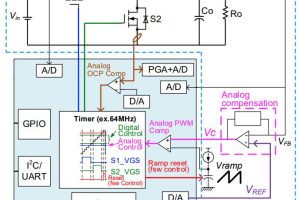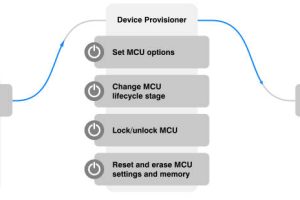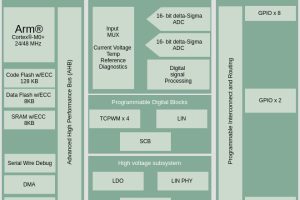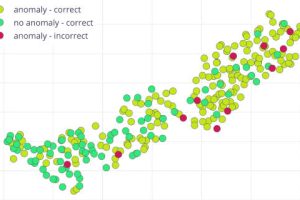In choosing to put RISC-V cores on its new microcontroller – fear not, there are Arm Coretex-M33 cores too – Raspberry Pi will be helping put this architecture on the map. Proc0 and Proc1 can independently be set to be an Arm Cortex-M33 or a RISC-V core at boot Not that RISC-V is not already climbing rapidly in the instruction ...
Tag Archives: microcontroller
RP2350 available by year end, with flash-inclusive option
Raspberry Pi’s RP2350, its second-generation microcontroller, will be available by the end of the year in flash-less and flash-inclusive forms, in two packages: RP2350A QFN60 no flash $0.80 RP2350B QFN80 no flash $0.90 RP2354A QFN60 2Mbyte flash $1.00 RP2354B QFN80 2Mbyte flash $1.10 QFN60 types are 7 x 7mm and have 30 GPIOs, QFN80 types are 10 x 10mm and ...
New Raspberry Pi MCU – RP2350 – Risc-V, Arm and security
Raspberry Pi has announced its second microcontroller, the RP2350, adding two RISC-V cores alongside improved Arm cores, more ram, and security. Not initially available on its own (ETA pre-year-end), it will first ship as part of the Raspberry Pi Pico 2 single-board microcontroller (right) – which is the same 21 x 51mm size as the original Pico, and priced from ...
Gadget Book: Microcontroller Exploits
There's seriously detailed microcontroller content in this book - Microcontroller Exploits - which documents a variety of microchip hacking techniques.
16bit MCUs for hybrid analogue-digital PSU control
Rohm has released a line of 16bit microcontrollers for power supplies with hybrid analogue-digital control loops, plus an evaluation board with software as a design stepping stone. “In recent years medium power power supplies are required to provide a level of reliability and precise control that is difficult to meet with analogue-only configurations,” said Rohm. “On the other hand, while ...
46Gop/s of neural network processing in a 3.9 x 3.9mm package
Alif Semiconductor has removed the Bluetooth transceiver from its Balletto B1 microcontroller to create an MCU with (or without) 46Gop/s of neural network processing that will be available in packages as small as a 3.9 x 3.9mm 90bump WLCSP. Dubbed E1C, the family all get a single 160MHz Arm Cortex-M55 CPU with Helium vector processing extensions, then some will also ...
Provision secure MCU features in production
Segger has introduced microcontroller security feature configuration to its in-circuit programmers, debug probes and trace probes. “Modern chips require an increasing level of customer and device-specific configuration,” according to the company. “The driving force is security, especially as more and more devices connect to the Internet. Unfortunately, there is no industry standard for provisioning device security and configuration. Options differ ...
High analogue accuracy automotive MCU survives 42V
Infineon has introduced microcontrollers for monitoring vehicle Pb-acid batteries, that can be powered directly from the battery and include a pair of high-accuracy ADCs. Operation is over 3.6 to 28V, with reduced function up to 42V, and the drvices have been developed with functional safety in mind. “The device is developed compliant to ISO 26262, meeting all process requirements for ...
Found a 100MHz dev board at last
One of the monomaina’s in Wonderland is ‘building a better pulse generator’, for want of a better phrase. It should be so easy with all the Arduino-esk microcontroller boards out there that have lovely timers inside, but a recurrent drawback is that it is hard to find one that runs at a ‘nice’ frequency – one with a clock period ...
MCU-based AI tool detects visual anomalies rather than known features
Edge Impulse has introduced AI software for Arm microcontrollers and Nvidia processors intended to spot previously unseen and untrained anomalies in images, for industrial inspection, medical imaging and logistics, for example. It is based on ‘Gaussian mixture models’ – GMMs. “Neural networks are powerful but have a major drawback: handling unseen data, like defects in a product during manufacturing, is ...
 Electronics Weekly Electronics Design & Components Tech News
Electronics Weekly Electronics Design & Components Tech News
